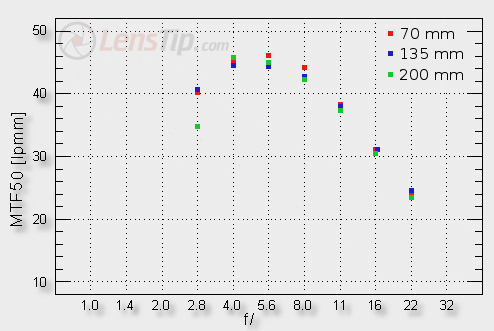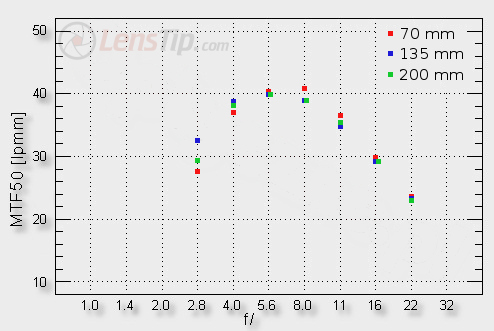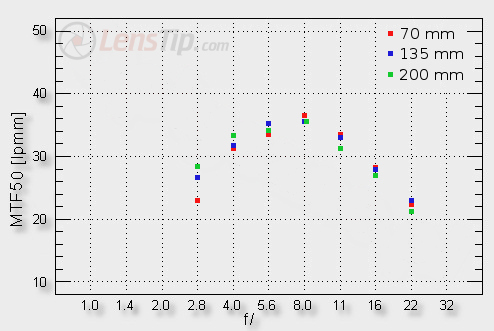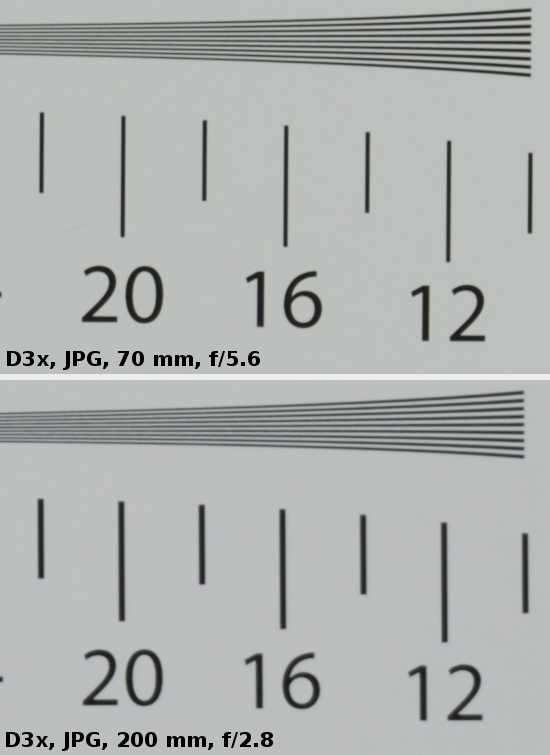Nikon Nikkor AF-S 70-200 mm f/2.8G ED VR II
4. Image resolution
Let’s start with describing the tested lens’s performance in the frame centre. It would be a quite natural thing to compare it with the previous version but we tested the older lens on the Nikon D200 which is not a full frame camera. The values in the frame centre of the D3x and the D200 are quite easily comparable though – the same lenses tested on both bodies have results by about 1 lpmm worse on the D3x. To compare the graphs, presented here, the results of the older Nikkor 70-200 mm VR on the D200 have to be reduced by the value of about 1 lpmm.

Please Support UsIf you enjoy our reviews and articles, and you want us to continue our work please, support our website by donating through PayPal. The funds are going to be used for paying our editorial team, renting servers, and equipping our testing studio; only that way we will be able to continue providing you interesting content for free. |
- - - - - - - - - - - - - - - - - - - - - - - - - - - - - - - - - - - - - - - - - - - - - - - -
The new Nikkor performs very evenly and it really sticks out. The older lens, although it reached very similar values, showed bigger differences between particular focal lengths, being the best at 70 mm and the worst at 200 mm. Because of that you can notice that at 70 mm the older Nikkor is slightly better than the new and at the longer focal lengths the reverse is the case – the new lens fares better. The differences are not significant though. In the end, looking at the frame centre of full frame or a DX sensor, it will be very difficult to notice them in real life. Both lenses manage to perform very well even wide open, producing fully useful sharp images; on slight stopping down they reach even very high MTF50 values.
Let’s pass to the DX sensor’s edge performance. The appropriate graph is presented below.

Here the differences between the new lens and the old one are more pronounced. Once again the same factors should be considered though. The older model shows distinct differences between particular focal lengths. Longer end definitely lags behind the best focal length of 70 mm. The new Nikkor 70-200 mm fares still very evenly, the results obtained at every focal length and aperture are in fact the same within the margin of error. The important thing is that even at the maximum relative aperture the lens reaches values near 30 lpmm so it gives us completely useful images. What’s more, at longer focal lengths it improves faster than its predecessor, obtaining high MTF50 values. On stopping down to f/4.0 we reach the vicinity of 40 lpmm at all focal lengths. In the case of the older Nikkor, in the range of 135-200 mm and by f/4.0, there were problems with getting to 35 lpmm. Our initial speculations that the new version of the lens was launched mainly to improve the frame edge performance are proven to be right.
Unfortunately the older version of the Nikkor 70-200 mm wasn’t tested on full frame. If the difference in favour of the new version was already seen at the edge of the DX sensor we can reasonably expect that at the edge of full frame it will be even more visible. It’s only a speculation but luckily when it comes to the performance of the new Nikkor 70-200 mm at the edge of the FX sensor we don’t have to speculate anymore because we have full results available. You can see them presented on the graph below.

You could complain a bit about the performance at maximum relative aperture, where at no focal length the lens exceeds the level of 30 lpmm. The important thing is that we get near that value and we deal here with the edge of full frame and a quite fast zoom lens to boot. What’s more, the image quality improves relatively quickly on stopping down. By f/4.0 we get fully sharp images and by f/5.6-8.0 the images are simply beyond reproach. Once again the very even performance of the lens at all focal lengths should be praised here.
At the end let us present some frame centre crops of our test chart which were saved in the JPEG format along with RAW files. Only RAW files were used to generate the graphs above.
 |






